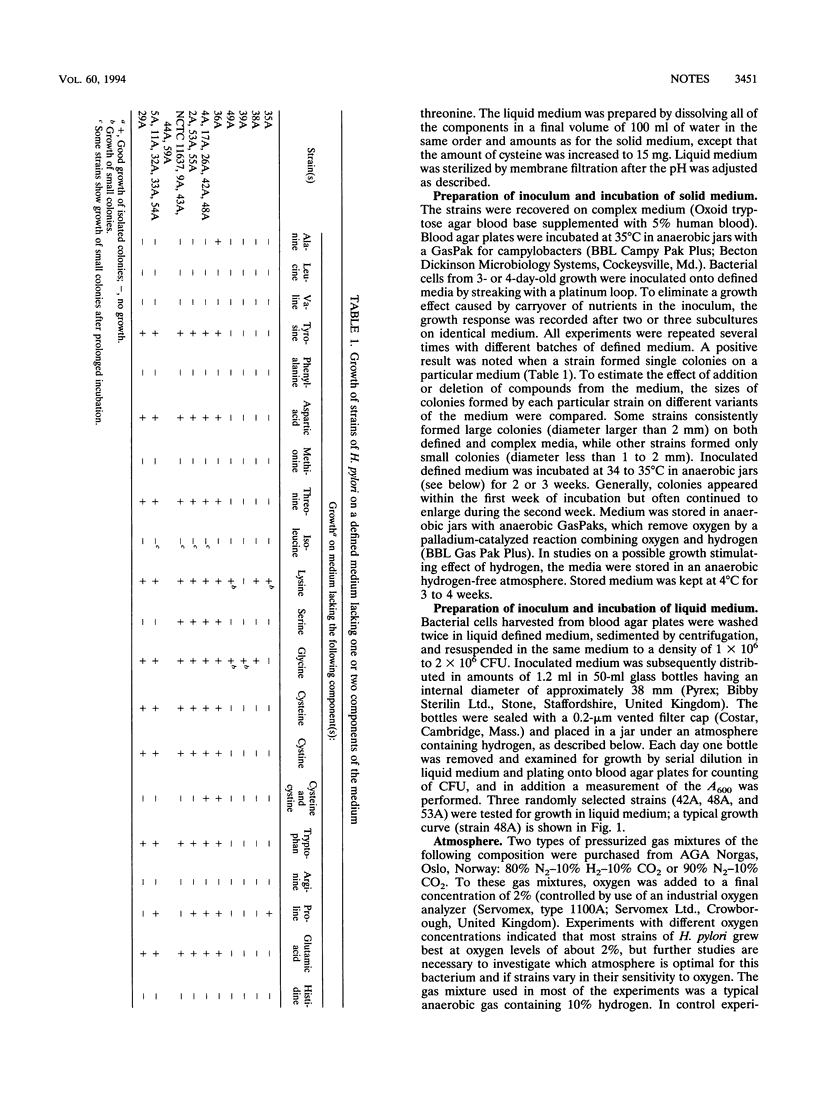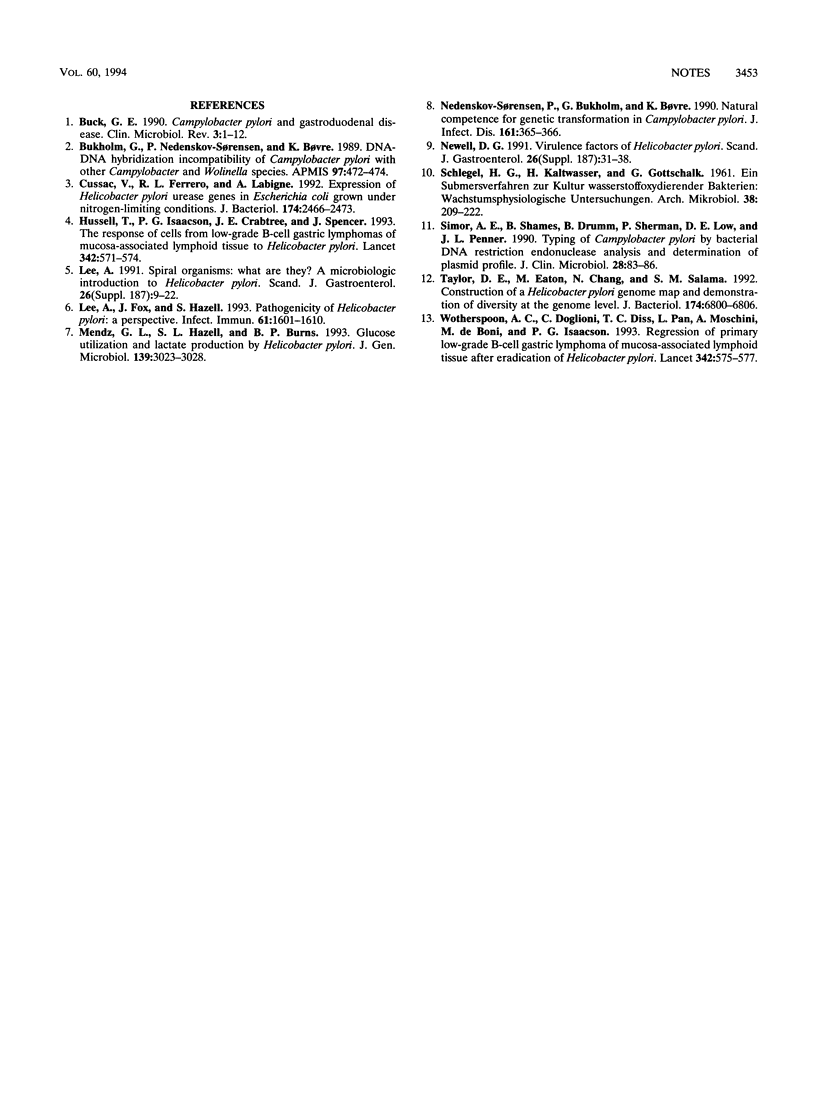Abstract
A chemically defined medium consisting of a buffered mineral base supplemented with amino acids, a purine, and thiamine supported growth of 23 clinical isolates and the type strain of Helicobacter pylori. The growth of four strains was inhibited by the presence of certain amino acids. All but one strain required alanine for growth. The amino acids leucine, valine, phenylalanine, methionine, arginine, and histidine were generally required. Isoleucine either was required or stimulated growth. Strains could be differentiated into groups on the basis of a requirement for one or more of the amino acids cysteine, serine, and proline. Only one strain however, demonstrated a requirement for all three of these amino acids.
Full text
PDF



Selected References
These references are in PubMed. This may not be the complete list of references from this article.
- Buck G. E. Campylobacter pylori and gastroduodenal disease. Clin Microbiol Rev. 1990 Jan;3(1):1–12. doi: 10.1128/cmr.3.1.1. [DOI] [PMC free article] [PubMed] [Google Scholar]
- Bukholm G., Nedenskov-Sørensen P., Bøvre K. DNA-DNA hybridization incompatibility of Campylobacter pylori with other Campylobacter and Wolinella species. APMIS. 1989 May;97(5):472–474. [PubMed] [Google Scholar]
- Cussac V., Ferrero R. L., Labigne A. Expression of Helicobacter pylori urease genes in Escherichia coli grown under nitrogen-limiting conditions. J Bacteriol. 1992 Apr;174(8):2466–2473. doi: 10.1128/jb.174.8.2466-2473.1992. [DOI] [PMC free article] [PubMed] [Google Scholar]
- Hussell T., Isaacson P. G., Crabtree J. E., Spencer J. The response of cells from low-grade B-cell gastric lymphomas of mucosa-associated lymphoid tissue to Helicobacter pylori. Lancet. 1993 Sep 4;342(8871):571–574. doi: 10.1016/0140-6736(93)91408-e. [DOI] [PubMed] [Google Scholar]
- Lee A., Fox J., Hazell S. Pathogenicity of Helicobacter pylori: a perspective. Infect Immun. 1993 May;61(5):1601–1610. doi: 10.1128/iai.61.5.1601-1610.1993. [DOI] [PMC free article] [PubMed] [Google Scholar]
- Mendz G. L., Hazell S. L., Burns B. P. Glucose utilization and lactate production by Helicobacter pylori. J Gen Microbiol. 1993 Dec;139(12):3023–3028. doi: 10.1099/00221287-139-12-3023. [DOI] [PubMed] [Google Scholar]
- Nedenskov-Sørensen P., Bukholm G., Bøvre K. Natural competence for genetic transformation in Campylobacter pylori. J Infect Dis. 1990 Feb;161(2):365–366. doi: 10.1093/infdis/161.2.365. [DOI] [PubMed] [Google Scholar]
- Newell D. G. Virulence factors of Helicobacter pylori. Scand J Gastroenterol Suppl. 1991;187:31–38. [PubMed] [Google Scholar]
- SCHLEGEL H. G., KALTWASSER H., GOTTSCHALK G. [A submersion method for culture of hydrogen-oxidizing bacteria: growth physiological studies]. Arch Mikrobiol. 1961;38:209–222. [PubMed] [Google Scholar]
- Simor A. E., Shames B., Drumm B., Sherman P., Low D. E., Penner J. L. Typing of Campylobacter pylori by bacterial DNA restriction endonuclease analysis and determination of plasmid profile. J Clin Microbiol. 1990 Jan;28(1):83–86. doi: 10.1128/jcm.28.1.83-86.1990. [DOI] [PMC free article] [PubMed] [Google Scholar]
- Taylor D. E., Eaton M., Chang N., Salama S. M. Construction of a Helicobacter pylori genome map and demonstration of diversity at the genome level. J Bacteriol. 1992 Nov;174(21):6800–6806. doi: 10.1128/jb.174.21.6800-6806.1992. [DOI] [PMC free article] [PubMed] [Google Scholar]
- Wotherspoon A. C., Doglioni C., Diss T. C., Pan L., Moschini A., de Boni M., Isaacson P. G. Regression of primary low-grade B-cell gastric lymphoma of mucosa-associated lymphoid tissue type after eradication of Helicobacter pylori. Lancet. 1993 Sep 4;342(8871):575–577. doi: 10.1016/0140-6736(93)91409-f. [DOI] [PubMed] [Google Scholar]


